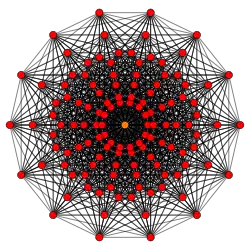Quarter 8-cubic honeycomb
| quarter 8-cubic honeycomb | |
|---|---|
| (No image) | |
| Type | Uniform 8-honeycomb |
| Family | Quarter hypercubic honeycomb |
| Schläfli symbol | q{4,3,3,3,3,3,3,4} |
| Coxeter diagram | |
| 7-face type | h{4,36},  h6{4,36},  {3,3}×{32,1,1} duoprism {31,1,1}×{31,1,1} duoprism |
| Vertex figure | |
| Coxeter group | ×2 = [[31,1,3,3,3,3,31,1]] |
| Dual | |
| Properties | vertex-transitive |
In seven-dimensional Euclidean geometry, the quarter 8-cubic honeycomb is a uniform space-filling tessellation (or honeycomb). It has half the vertices of the 8-demicubic honeycomb, and a quarter of the vertices of a 8-cube honeycomb.[1] Its facets are 8-demicubes h{4,36}, pentic 8-cubes h6{4,36}, {3,3}×{32,1,1} and {31,1,1}×{31,1,1} duoprisms.
See also
Regular and uniform honeycombs in 8-space:
- 8-cube honeycomb
- 8-demicube honeycomb
- 8-simplex honeycomb
- Truncated 8-simplex honeycomb
- Omnitruncated 8-simplex honeycomb
Notes
- ^ Coxeter, Regular and Semi-Regular Polytopes III, (1988), p318
References
- Kaleidoscopes: Selected Writings of H. S. M. Coxeter, edited by F. Arthur Sherk, Peter McMullen, Anthony C. Thompson, Asia Ivic Weiss, Wiley-Interscience Publication, 1995, ISBN 978-0-471-01003-6 [1] Archived 2016-07-11 at the Wayback Machine
- (Paper 24) H.S.M. Coxeter, Regular and Semi-Regular Polytopes III, [Math. Zeit. 200 (1988) 3-45] See p318 [2]
- Klitzing, Richard. "7D Euclidean tesselations#7D".
| Space | Family | / / | ||||
|---|---|---|---|---|---|---|
| E2 | Uniform tiling | 0[3] | δ3 | hδ3 | qδ3 | Hexagonal |
| E3 | Uniform convex honeycomb | 0[4] | δ4 | hδ4 | qδ4 | |
| E4 | Uniform 4-honeycomb | 0[5] | δ5 | hδ5 | qδ5 | 24-cell honeycomb |
| E5 | Uniform 5-honeycomb | 0[6] | δ6 | hδ6 | qδ6 | |
| E6 | Uniform 6-honeycomb | 0[7] | δ7 | hδ7 | qδ7 | 222 |
| E7 | Uniform 7-honeycomb | 0[8] | δ8 | hδ8 | qδ8 | 133 • 331 |
| E8 | Uniform 8-honeycomb | 0[9] | δ9 | hδ9 | qδ9 | 152 • 251 • 521 |
| E9 | Uniform 9-honeycomb | 0[10] | δ10 | hδ10 | qδ10 | |
| E10 | Uniform 10-honeycomb | 0[11] | δ11 | hδ11 | qδ11 | |
| En−1 | Uniform (n−1)-honeycomb | 0[n] | δn | hδn | qδn | 1k2 • 2k1 • k21 |